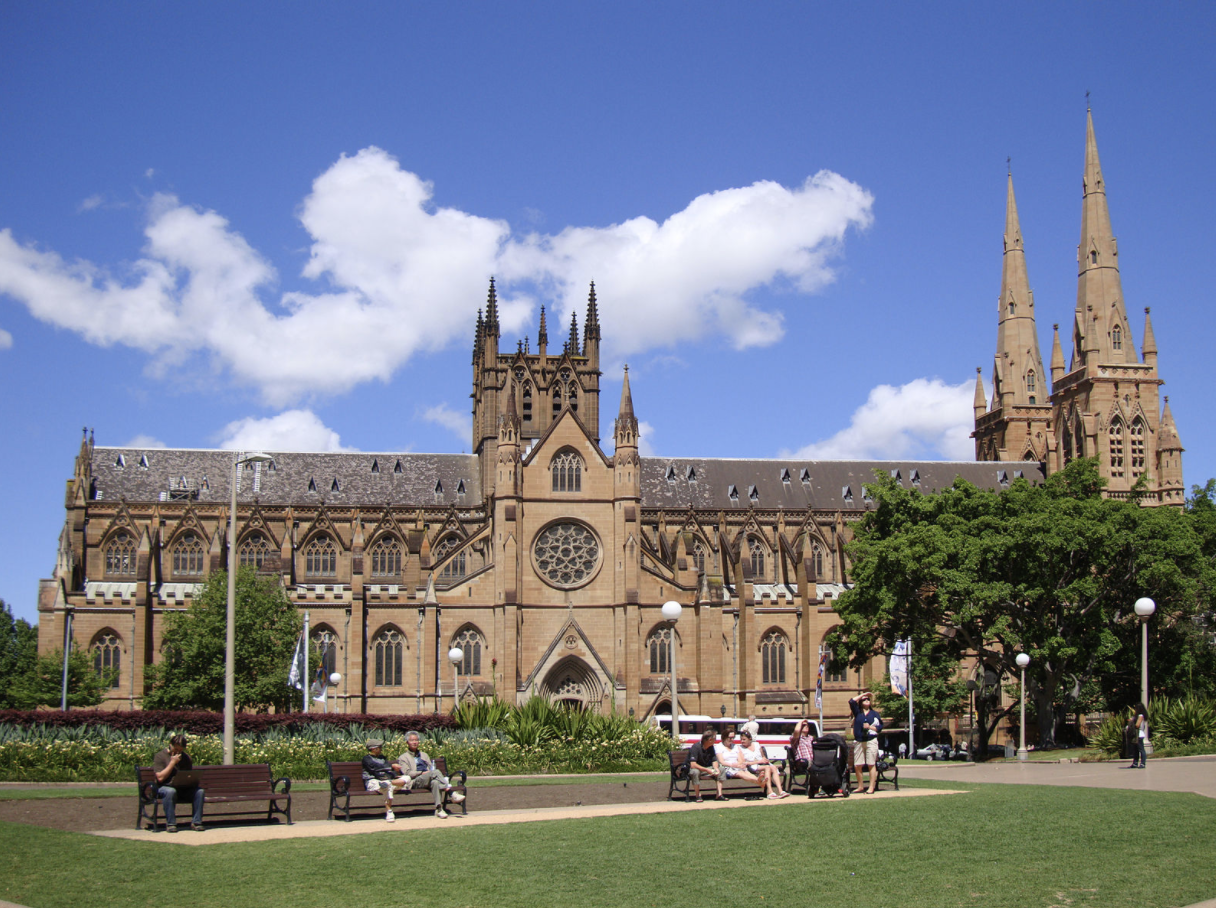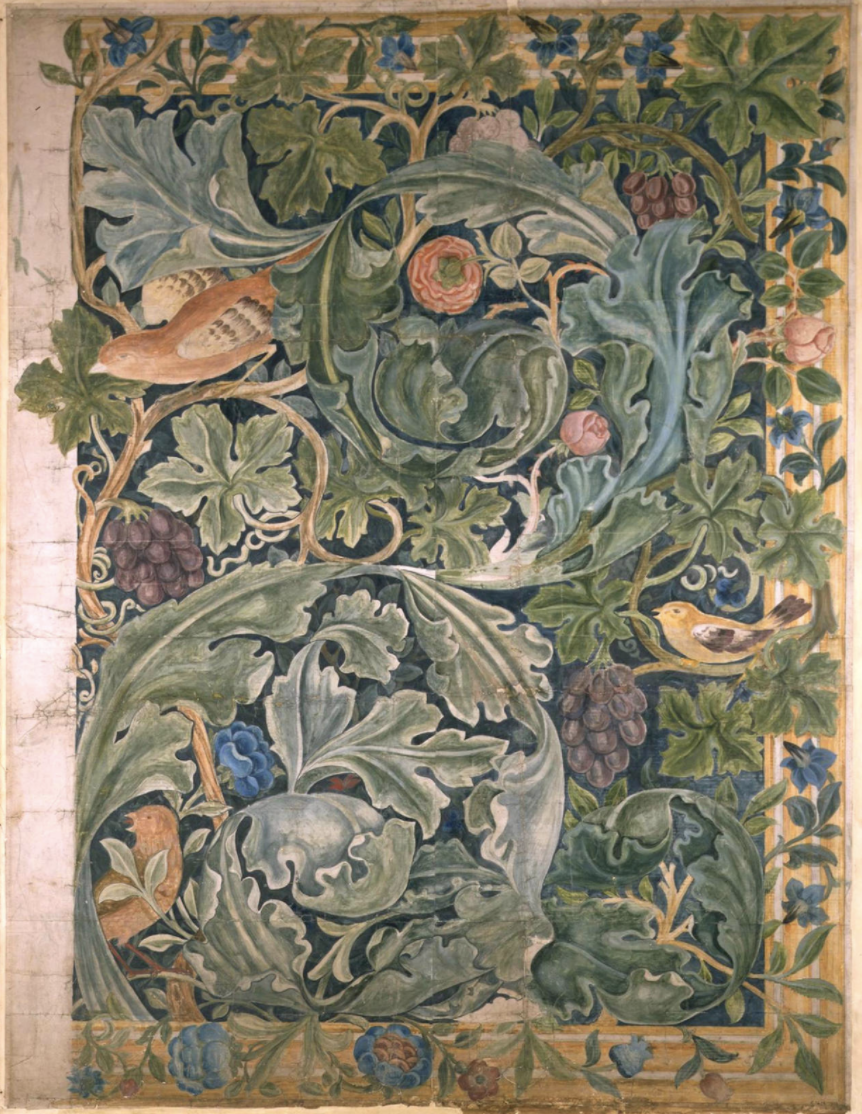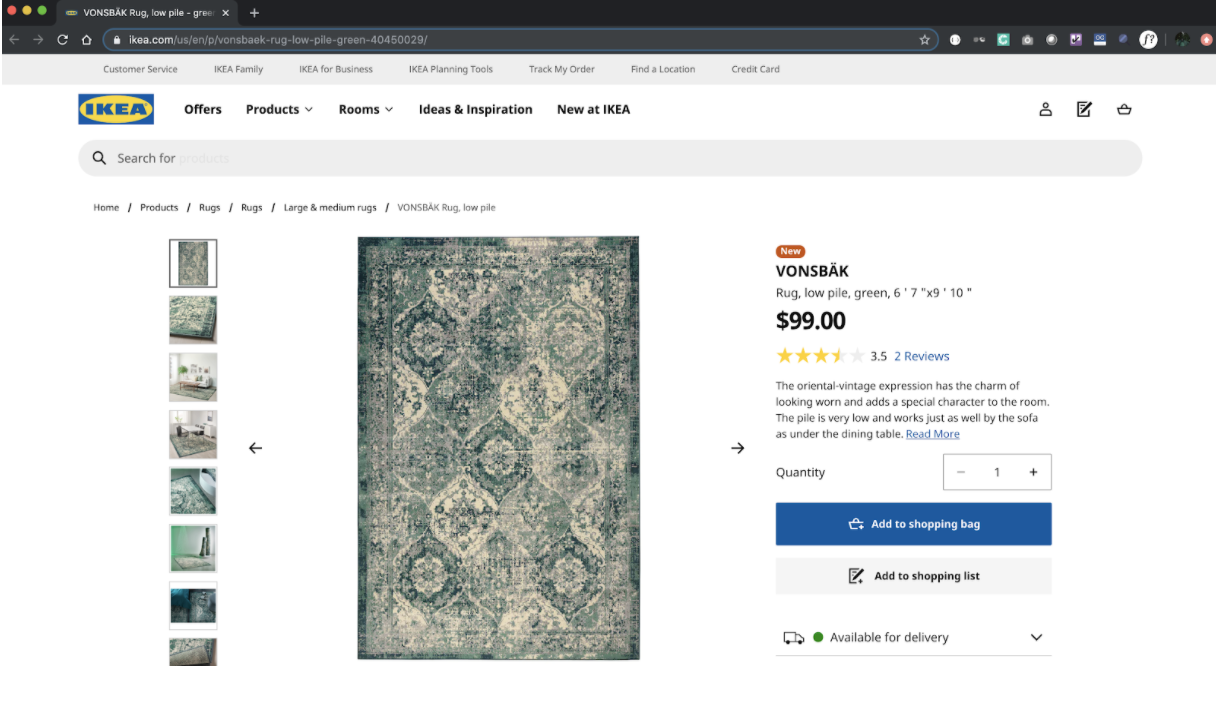Introduction
Tradition is used as scaffolding to ground a culture’s identity during times of change. The recollection (or formation) of tradition occurs more frequently under rapid transformations in society, or when a way of life feels threatened. Unstable social climates, such as industrialization in 19th century Britain, or the rapidly expanding 21st century digital age, threaten to destroy existing traditions. Because of this, new traditions are updated, or as Hobsbawm and Ranger would suggest, ‘invented,’ to resist the contemporary climate. During the Industrial Revolution, some people looked to historical examples of art and design as a way of trying to return to a romanticized moral home, a way of maintaining self-identity as the world changed. Through the practice of Gothic Revival design, the focus of craft in the Arts and Craft movement, and the role of textiles in the ideological competition between industrial manufacture and traditional techniques and motifs, it is clear that throughout the past 200 years of Western society, traditions are oftentimes invented or repurposed to create and anchor a group identity with a set of moral values that oppose large scale social change and progress. Tradition is used dually by traditionalists and progressive parties to accomplish their goals, with both groups appropriating and recontextualising historic ‘tradition’ to produce reception in audiences. It may even be suggested that by inventing traditions, the act of dislodging aesthetics from their original purpose and meaning, and applying new contexts, makes them more susceptible to appropriation and repurposing in industry, and furthermore weakens the original meaning of the style they pull from.
The Industrial Revolution of the 18th and 19th centuries in Great Britain led to one of the first examples of traditionalism and nostalgia within the nation. The Industrial Revolution saw mass population movement into cities, the formation of slums, child labour, and low living conditions as mass manufacturing exploded, namley surrounding the textile industry. There was an overall discontent with the social conditions in Britain, as well as – amongst designers – dissatisfaction with the quality of these new mass-produced goods. The drastic social, economic, and cultural changes that resulted from the technological advancements led to backlashes amongst the population, where people searched for cultural identity during the drastic changes. Simultaneously during this time, Britain was also a dominant colonial power, with possessions in Asia and the near East, and colonies across Africa and Ocieania. There was an introduction of cultural aesthetics and goods from these distant lands, that quickly proliferated into constructed environment of the Britons. Concurrently, there was need to project a sense of British identity and strength onto these lands. In a rapidly changing cultural landscape, Great Britain was in need of an identity, where sentiments of tradition could help ground and steady the culture during times of drastic change.
In Cities Built to Music, Michael Bright argues that the Victorians of the 19th century were self-conscious and concerned about their legacy or identity. Many British citizens, felt unsettled and disillusioned with the government and ideals of the time. Governments wished to project a broader sense of nationalism to produce cohesion at home and abroad amongst the colonies. Though both these parties grappled with identity for different intentions, the similar reasons for this identity crisis resulted in the British searching for some kind of source to ground their identity. According to Immanuel Wallerstein, culture allows groups to self-identify, and differentiate themselves from one another. Traditions are one way that those of a similar culture can connect. During the Industrial Revolution, traditions such as hand-making art and objects were in danger of going extinct. As traditions simultaneously help to ground and connect a group during times of change, whilst also combat encroaching practices from those who are deemed threatening, many designers and those active in politics engaged in resurfacing traditions to promote dying ideals and styles that they felt evoked a better vision of moral and cultural identity.
One of the most famous examples of this was in Gothic Revival design, the mid-19th century movement that romanticized medieval gothic styles as opposed to classical architecture and mass manufacture that were popular during Victorian Britain. John Ruskin’s seminal work, The Stones of Venice, particularly the chapter “The Nature of Gothic,” helped to present Gothic architecture as a more honest expression of design, and of the British identity. Not only was it more aesthetically true to British heritage, he argued, but it also was morally good for society. Gothic Revival represents illustrative example of practitioners returning to traditional design language. However, design reformists attached moral values to it, extending or recontextualising the original meaning of Gothic design vernacular. Designers used traditionalism in design to form new social values and myths. They presented new contexts for old design. The morals associated with Gothic Revival were new, and used traditional aesthetics to accomodate a new sense of British identity.
The phenomena of resurfacing and recontextualising old traditions is described by Hobsbawm and Ranger in their book The Invention of Tradition as ‘invented traditions.’ They argue that ‘invented traditions’ are often key drivers in the formation of nationalism and group identity. These new traditions draw on nostalgic feelings of identity as a way to create cohesion across a culture. Hobsbawm and Ranger offer a framework to analyse ‘traditional’ design movements that sprung up as a result of the Industrial revolution. Traditions are resurfaced as a way or harking back to a ‘better,’ more morally good time. As Roland Barthes mentions in his landmark essay on semiotics Rhetoric of the Image, connoted symbolic messages (eg. pastoral Gothic imagery harkening back to a ‘simpler,’ more conservative time) that leverage cultural contexts and understanding – a rhetoric – can effectively communicate and transport deep cultural ideas through imagery to a contemporary audience. By attaching new values to old aesthetics, these powerful cultural signs or traditions carry new symbols. However, the creation of new meaning may in fact weaken both the authentic tradition, and the new values addressed to it. Because of this, the repurposing of tradition leads these new movements to be more susceptible to misinterpretation or outright appropriation by others as a tool for achieving their own goals.
An example of this can be seen in the colonial Architecture of this time. Gothic Revival churches pollinated English culture, ‘tradition,’ and ideals throughout the English colonies. But these works clearly represent ‘invented traditions.’ Gothic churches never existed in the continent of Australia, all gothic design seen today was imported as a new style, with different ideals and motives compared to the original churches built in Great Britain and Western Europe. The St Mary’s Cathedral of Sydney (fig 1), completed between 1851 - 1928 with the input of Gothic Revival practitioner Augustus Pugin, shows the problematic relationship between the intention and the outcome of Gothic Revival architecture. Gothic revival intended to exalt the craftsman, the medieval village, and the goodness of traditional hand-built structures, an embodiment of limiting industry and immoral progress. However, “Englishness” of St Mary's Cathedral in Sydney was one of just aesthetic properties, most of its construction was with the use of modern tools and the labour of indentured servants and convicts. In Australia, colonies were formed by exporting a ‘criminal class’ of prisoners, those who were left disadvantaged during the industrial revolution. Now, Gothic Revival architecture was being used to subdue and connect with these populations through a sense of English identity. St Mary’s Cathedral represented the strength of British industry and power, suppressing local populations and helping to install urban centres that included factories and other social structures opposed by design reformists/ the gothic revival movement. Gothic revival architecture thus sits between mainstream progress and morally conservative traditions.
Traditionalists like Ruskin argued that the handcrafted workmanship of gothic architecture is what gave it meaning and beauty, its familiarity reinforced an “Englishness” that made people in industrial England yearn for a simpler, more morally ‘good’ time. However, Gothic revival architecture was used in colonial settings to embody the strength of England (and it’s industry) in new and unfamiliar places. By adapting gothic design to fulfill new values, the separation of meaning and aesthetic allowed the new invented style to become a vessel for artificial cultural identity and tradition, easily manipulated to suit the needs of those wielding it.
The Arts and Crafts movement is another example of designers revitalising traditional techniques, equipping them with new moral sentiments, and re-distributing them with the intention of creating identity and cultural change. The beliefs put forth by the Arts and Crafts movement and its founder William Morris in the late 1800s presented the notion that tradition and craft are necessary for the protection of society and culture. Morris argued for the importance and necessity of craft in a rapidly industrialising world. He suggested that aesthetics and quality of craft were linked to social conditions. Furthermore, he claimed that art and design can only be ‘popular’ if it is “noble, vital, and beautiful.” Arguing against industrialization, Morris’ stance is one that utilises tradition as a way of anchoring society and opposing industrial advancements. A political radical, he saw the political role and potential in design. Resisting capitalist industry, Morris’ art was as social as it was aesthetic. He used romantic and traditional imagery as an apparatus to project new political concepts that had only emerged in the 19th century, ideas that surely weren’t broadly discussed in rural medieval England. Because of this, the work of Morris can fit into the framework of invented traditions outlined by Hobsbawm and Ranger.
Morris’ textile work offer a unique view into the role of textiles in the conflict and collaboration between tradition and progress. Textiles, being a fundamental tool for humans in expressing culture whilst also being technologies that are used in industrial societies, have become a natural arena where the push and pull between progress and tradition and play out. The Industrial Revolution saw textiles at the forefront between this dualism. Technologies such as the jacquard loom and cotton gin, as well as the widespread social impact of textile factories, fundamentally shaped the context of textiles, and design practices as a whole. Yet textiles still have been able to represent the romanticisation of craft seen since the Industrial Revolution. In Gottfied Semper’s Four Elements of Architecture, he outlined how textiles were the first architecture, with weaving and shelter being the first fundamental technology used by humans. In doing so, Semper illustrates the fascinatingly nuanced role that textiles play in our society. They are traditional, old, a way of connecting with the past, and simultaneously an apparatus for progress, technological development, and change.
Morris himself was a practitioner of many different types of textiles, notably tapestries, which he referred to as “the noblest of all weaving arts.” The industrial revolution saw the influence of mass-produced textiles along with chemical dyes and a swath of overly ornamented fashion items. Morris turned to medieval design as a way of creating calm, idyllic scenes in his design work, using forms that design reformists would refer to as ‘honest.’ However this idea of honesty should be questioned. Much like how jeans today can be purchased as ‘pre-worn’ or already ripped, some of Morris’ designs were created to look faded (fig 2). It is artistic choices such as these that show that movements such as Arts and Craft were designed to pull on the emotional and social aspects of being human, rather than direct mimicry of historical designs.
Though it can be argued that Morris was in fact dishonest in his portrayal of a romantic England, his overall intention was to use his craft as a way of revitalising interest in handcrafted design. Here, tradition was used as a way of inviting an English population to his ideas and work, playing off of the emerging neo-gothic style. Once again, it is seen how tradition was used as a tool for inviting audiences to be receptive to larger design and cultural values.
Similarly to how the Industrial Revolution posed the threat of change and loss of identity to 19th century Victorians, Westerners today face widespread social and cultural shifts as a result of the rapid advancements in digital technologies and social media. The need for a feeling of identity as old ways of life begin to disappear has been satisfied again through the use of traditionalism. Rising fears of environmental shifts, politics, and “big” industry have invited millenials of the digital age to resist and search for ideals that represent a time that was meaningful to those who now feel it being lost. In the paper “Nostalgia: Conceptual Issues and Existential Functions,” authors Wildschut, Sedikides, and Baden propose that nostalgia reinforces (and informs) our psychological structures of identity, meaning, and cultural connection. The desire for the feeling of tradition fulfilled may in fact outweigh the necessity for actual traditions to remain. Though thrifting has grown in popularity as individuals look to populate their environments with artifacts of disappearing times, the digital revolution has facilitated the consumption of ‘tradition’ through the use of technology, allowing large manufacturers to effectively leverage nostalgic sentiments for the past to distribute new products.
Today, the use of ‘traditions’ to support industrial practices is rampant. H&M’s 2018 collection “Morris&Co x H&M” uses patterns derived from Morris’ woodblock prints and textiles in a line of clothing. It is an example of fast fashion linking itself to nostalgic traditions and pastoral Victorian imagery, as a way of altering consumer’s feelings of the brand. Traditionalism is communicated through promotional artifacts, including a highly glamorised film featuring Instagram models, photos on the website (fig 4), and an event at Morris’s famous Standen House featuring influencers wearing the garments. H&M subsequently appropriates the imagery of Morris, which was used as a protest against industrialization, and strips it of its original social values. Whilst both iterations of the original woodblock print stand as examples of returning to the past as a way of inspiring feelings of tradition, H&M’s repurposing of Morris’ craftwork exemplifies industry’s ability to use tradition as a way of currying favour with suspicious consumers.
H&M clearly misrepresents the original intention of Morris’ prints. However, it brings up the question as to what extent were Morris’ own designs properly traditional, as opposed to equally disingenuous representations of another time in their own right. William Morris produced original designs, yet this idea of originality may in fact undermine the intention of representing a past time period. Whereas medieval art may have been attempts from the artists to represent the world around them, Morris’ own art is a direct response to social movements and change. The intentionality of his work is different. Instead, he appropriates historic aesthetics, and uses them to further his own social values, creating a design aesthetic that uses traditionalism to gain popularity whilst simultaneously presenting a progressive sociopolitical perspective that is staged as traditional. It can be suggested that because Morris’ own designs are ‘invented traditions’ as Hobsbawm and Ranger would argue, it in fact weakens the connection between aesthetic and meaning. The result of this is that Morris’ meaning can be abstracted or remodeled by others. Ironically, mass producers like H&M subsequently have been able to use his design as a bridge to another time, much like he did. And like them, they have been able to manipulate the original intention of the art, romanticising it, and using it to encourage interest from others. Whilst Morris may have intended to resist industry with his design, he instead created an open door for the appropriation and romanticisation of his own work.
The diffusion of meaning in invented aesthetics of the 19th century has made it easy for manufacturers today to leverage misplaced sentiments that contemporary individuals express of the past. Owen Jones’ Grammar of Ornament discussed older styles of ornamentation in design from Britain and abroad in the 19th century as a way of encouraging the exploration of older artifacts to create new, ‘good’ design during a time of industrial mass-production. In this case, the exploration of the old was to create new and modern designs. Orientalism and appropriation of styles derived from indigenous population of Britain’s colonies were seen as modern. However, explorations of colonial art were so efficiently introduced into the vernacular of late-Victorian design that contemporaries today view invented ‘oriental’ rugs of the 19th century as traditional and nostalgic.
This dilution of meaning results in designs today being labelled as ‘traditional '. IKEA, a Swedish product manufacturer that despite specialising in mass producing disposable goods has a strong millennial following, has a large collection of such objects, particularly amongst their textiles. Many of their rugs play off of nostalgic sentiments. Products like the VONSBÄK rug (fig 5) are labeled with phrases such as “The pattern looks faded and worn, which gives the rug a vintage look similar to oriental rugs” and “The oriental-vintage expression and colors fit in both modern and traditional furniture.” Here, IKEA sells the buyer on the sensation of old, where the emotional power of traditionalism outweighs the reservations a user may have of the invented and artificial styles presented. Furthermore, the company taps into the idea that this representation of tradition is asirational, because it is adapted to modern life, its abstraction and misrepresentation of the time is actually valuable to the user, though this is hidden as positive consequence of staying ‘true’ to the vintage feel of the textile.
The rug itself is artificially worn, similar in fact to Morris’ own designs (fig 2). IKEA plays into both the feelings of rug - an object that represents craftsmanship and artistic expression, as well as the idea of age, that a worn object helps to symbolise a connection to another time. By purchasing this product, IKEA allows an individual to raise their hand and signify their connection to this ‘tradition’ of oriental rugs, despite the rug being purchased online direct from the factory with artificial aging. The original meaning surrounding Persian rugs was lost when they were reduced to aesthetic qualities by works such as Grammar of Ornament. Now symbols void of meaning, IKEA has been able to effectively invent traditions associated with these designs by loosley drawing connections between disparate ideas of the time. Oriental ornament was seen as modern, and pastoral ways of life experienced in the late 19the century by the British was a concept that was equally yearned for by designers such as Morris as it is today. The idea of tradition has thus become more important than actual tradition, and the act of inventing or repurposing the past to fulfill a desire to return to it has diluted the original meaning of the aesthetics mimicked by designers.
Through past and present practices, it is clear that throughout the past 200 years of Western society, traditions have oftentimes been invented or repurposed to create and anchor a group identity with a set of moral values that oppose large scale social change and progress. These manufactured traditions are formed with the intention of resisting change through the revitalization of craft or traditional design; however, they are commonly appropriated by others as a way of furthering industrial progress. As ideas are recycled, they lose their original meaning. Today, the widespread desire to identify oneself with a time that is fast expiring manifests itself in many ways, from IKEA rugs to the adoption of Mason Jars (another Industrial Revolution invention) to the HiraCam: HujiCam Instagram filters that mimic 1990s street photography aesthetics. Inventing new ways to connect with the past creates artificial traditions that anchor new culture. As individuals are able to identify with their cultural past, this same past loses meaning. In 100 years, will a researched be able to identify if a photograph adorned with a lens flare and orange capture time was taken in 1989, or 2019? Traditions are used equally by traditionalsits and progressive groups to accomplish a goal of linking the present to the past. The result of this is a reconstructed memory of history that weakens authentic tradition and meaning, and creates easily manipulated and appropriated new traditions.
References
Ashby, Charlotte. "Nation Building and Design: Finnish Textiles and the Work of the Friends of Finnish Handicrafts." Journal of Design History 23, no. 4 (2010): 351-65. http://www.jstor.org.libproxy.newschool.edu/stable/40958919.
Barthes, Roland. Image, Music, Text: Essays. Edited by Stephen Heath. New York: Hill and Wang, 2007.
Bright, Michael. Cities Built to Music: Aesthetic Theories of Victorian Gothic Revival. Ohio State Univ. Press, 1984.
Bronner, Simon J. Explaining Traditions: Folk Behavior in Modern Culture. University Press of Kentucky, 2011. http://www.jstor.org.libproxy.newschool.edu/stable/j.ctt2jcn8m.
Chrostowska, S. D. "Consumed by Nostalgia?" SubStance 39, no. 2 (2010): 52-70. http://www.jstor.org.libproxy.newschool.edu/stable/40801075.
H&M. “Morris&Co x H&M.” YouTube, uploaded by H&M, 3 October 2018, https://www.youtube.com/watch?v=stImlDvdVOY.
Hobsbawm, Eric J., and Terence Ranger. The Invention of Tradition. Cambridge: Univ. Press, 1983.
Hughes, Robert. The Fatal Shore: a History of the Transportation of Convicts, 1787-1868. London: Collins Harvill, 1987.
“Introducing Morris & Co x H&M: H&M US.” H&M. H&M, October 4, 2018. https://www2.hm.com/en_us/life/culture/inside-h-m/introducing-morris---co-x-h-m.html.
Jones, Owen. The Grammar of Ornament. London: Day and Son, 1856.
Lees-Maffei, Grace, and Kjetil Fallan. "INTRODUCTION: National Design Histories in an Age of Globalization." In Designing Worlds: National Design Histories in an Age of Globalization, edited by Lees-Maffei Grace and Fallan Kjetil, 1-22. NEW YORK; OXFORD: Berghahn Books, 2016. http://www.jstor.org.libproxy.newschool.edu/stable/j.ctv8bt1mv.4.
Morris, William. “Textiles.” Journal of the Society of Arts 36 (October 19, 1888): 1133–35. https://books.google.com/books?id=7lEmAQAAIAAJ&printsec=frontcover&source=gbs_ge_summary_r&cad=0#v=onepage&q&f=false.
Morris, William. “William Morris, ‘The Lesser Arts.’” In The Industrial Design Reader, 35–40. NY, NY: Allworth Press, 2003.
“Pugin's Buildings: Australia.” The Pugin Society. Accessed November 11, 2019. http://www.thepuginsociety.co.uk/sydney2.html.
Rodulfo, Kristina. “This Is the Disposable Camera App All the Cool Kids Are Using on Instagram.” ELLE. ELLE, March 26, 2018. https://www.elle.com/culture/a19593003/disposable-camera-filter-app-huji-instagram/.
Ruehl, Isabel C. “Out With the Old and In With It Too: Thrifting Is 'In' in Cambridge: Arts.” The Harvard Crimson, April 30, 2019. https://www.thecrimson.com/article/2019/4/30/cambridge-thrift-shops/.
Ruskin, John. The Stones of Venice. London: Smith, Elder, and Co., 1853.
Sari, Talia, and Shovava. “Art History: Ancient Practice of Textile Art and How It Continues to Reinvent Itself.” My Modern Met, October 3, 2017. https://mymodernmet.com/contemporary-textile-art-history/.
Sedikides, Constantine, Tim Wildschut, and Denise Baden. “Nostalgia: Conceptual Issues and Existential Functions.” In Handbook of Experimental Existential Psychology, 200–214. NY, NY: Guilford Press, 2004.
Semper, Gottfried. The Four Elements of Architecture and Other Writings. Trans. Harry F. Mallgrave and Wolfgang Herrmann (Cambridge, 1989).
“V&A · William Morris Textiles.” Victoria and Albert Museum. Accessed October 24, 2019. https://www.vam.ac.uk/articles/willam-morris-textiles.
“VONSBÄK Rug, Low Pile - Green.” IKEA. Accessed November 8, 2019. https://www.ikea.com/us/en/p/vonsbaek-rug-low-pile-green-40450029/.
Wallerstein, Immanuel. “Culture as the Ideological Battleground of the Modern World-System.” Theory, Culture & Society, vol. 7, no. 2-3, 1990, pp. 31–55., doi:10.1177/026327690007002003.




